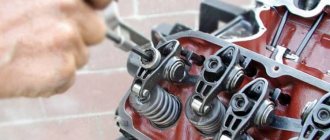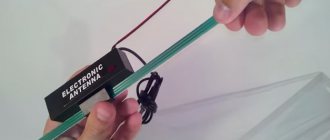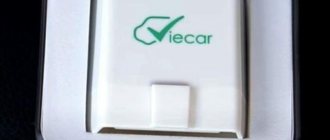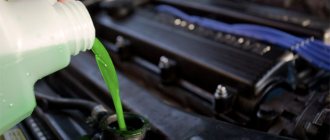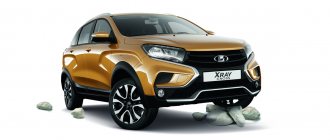Any car after the start of mass production is subjected to all kinds of crash tests. For the most part, these tests are aimed at identifying the degree of passenger safety in multidirectional collisions - frontal, side, rear. But there are also tests that simulate minor impacts, such as, for example, the Danner crash test (also called the “insurance test”). Its task is to determine the degree of damage to the car during minor impacts. Essentially, this test simulates minor accidents that often occur in city traffic. Such a crash test was carried out on the Lada X-Ray, a new crossover jointly produced by AvtoVAZ and Renault. Thanks to this test, you can roughly determine the cost of restoring a car after an accident.
The peculiarity of checking a car using the Danner method (also known as the RCAR test) comes down to the fact that the car hits an obstacle at a speed of 15 km/h. In this case, the impact should fall on the left side (40% overlap of the front part of the car), and the barrier itself should be non-deformable and located at a slope of 80 degrees. A prerequisite is also to load the test vehicle with a load weighing 50 kg.
Crash test Lada X-Ray
The newest Russian car, Lada X-Ray, is being made by AvtoVAZ with the expectation of receiving the highest quality ratings not only from Russians, but also from foreign professionals.
The Russian manufacturer has set itself the goal of creating a reliable and harmless crossover that will be able to protect the driver and passengers from injury if the car gets into a traffic accident and under other unfavorable circumstances. Lada Xray has received a number of effective security systems that will increase its chances of passing testing. In order to gain authority and trust from foreign professionals and car enthusiasts, the manufacturers of the Lada X-Ray plan to receive three stars based on crash test results in the prestigious Euro NCAP rating. The best cars in the world undergo this crash test, and the highest score based on the result of passing it is a typical sign of performance and safety, which will open the Lada Xray to the foreign market. The test will be carried out as soon as possible.
What experts say
Today, absolutely every car enthusiast knows that the basis of the first Russian crossover was the Renault Duster and Lada C-Cross, which was introduced several years ago. There is a certain similarity between these machines, you just have to look closely at the photo.
It is worth recalling that Renault Duster was able to pass the safety tests only with a weak “C”. However, if for a foreign crossover a three on the NCAP scale is not the ultimate dream, then for Lada cars this is simply an excellent result.
Why is Lada X-Ray required to successfully pass a crash test?
The former manager of AvtoVAZ, Bo Andersson, stated that ensuring the highest level of safety of the Lada X-Ray and successfully passing crash tests are the company’s two main tasks.
AvtoVAZ painstakingly prepared the Lada X-Ray for the crash test. The car has a reinforced body, as well as the following components that increase its safety:
- front and rear doors are equipped with security bars;
- bumpers have increased strength due to the presence of additional protective beams;
- roof reinforcements are integrated;
- there are side pillars of the body.
All trim levels of the newest Lada X-Ray, starting with the basic one, are equipped with safety airbags for the driver and a similar attribute for the front passenger. The best equipment includes side airbags.
The basic equipment of the newest Lada Xray includes:
- driver's airbag;
- front passenger pads.
What aspects are assessed in a crash test?
Lada Xray will be subject to tests that will evaluate the following characteristics:
- driver safety;
- protection of adult passengers;
- safety of children;
- safety of cars for pedestrians.
As a result of the assessment of these points, an overall rating is displayed, which shows the overall safety of the vehicle based on the results of crash tests.
High-quality safety belts increase the Lada X-Ray's chances of passing a crash test
All car options require the presence of three-point inertial belts, which firmly fix the passenger and driver in the seat.
The belts have overload limiters and special pretensioners on the front seats of the car. Similar belts are installed on the rear seats.
The seats have L-shaped headrests that firmly support the neck and prevent neck injuries in the event of tragedies. Lada X-Ray has reliable fixation of child seats (ISOFIX). In the event of critical braking in the car, the emergency alarm system is automatically activated. If there is a strong impact on the car body, the doors open without the help of others. In critical situations and during road accidents (Road accident (car accident, car accident) - an event that occurred during the movement of a vehicle on the road and with its participation, in which people were killed or injured, vehicles, structures, cargo were damaged, or other damage was caused material damage)
The ERA-GLONASS system turns on. The success rate of crash tests of the Lada X-Ray will be enhanced thanks to the modern electrical safety system and vital computer technologies, which were extensively used by AvtoVAZ engineers when developing the car.
Before release, almost all parts underwent computer testing, and then were completed in hardware.
This approach to the production of Lada Xray allows us to create the most durable car and saves money spent on creating test models.
Passive preservation
Equipping the vehicle well with elements of passive safety is the key to successfully passing the tests. Closed crash tests of the Lada X-Ray showed that the car has a good passive safety system, which was designed on the B0 technological base. This assembly (like the Lada Xray) is used in almost all European cars and has been used by almost all manufacturers, such as Renault, Nissan, Dacia for more than a year.
- driver, passenger and side airbags;
- reliable fastening of child seats;
- safety belts (three-point);
- belt tensioner.
Lada Xray is quite ready to pass the crash test according to Euro NCAP standards. Active and passive systems installed in the Lada X-Ray provide reliable protection for the life and health of all people who are in the car and follow safety precautions and traffic rules. AvtoVAZ management expects the Lada Xray to receive three stars in the Euro Ncap crash test, which is a good result, especially for cars of a similar price group.
Source: vestaxray.ru
About security
Lada Largus has become popular among motorists. Not the least role in this was played by numerous borrowings of ideas used on the French station wagon, produced until 2006. In the minimum configuration, as well as in the “norm” version, in addition to audio preparation and a standard 4-cylinder engine, the manufacturer offered one front airbag for the driver, which was not bad at that time.
As for the materials used in production, they are standard for modern automotive industry. Their quality, traditionally for domestic manufacturers, is not the highest in order to reduce the cost. Many motorists, especially the old generation, complain that previously the metal of the body was much thicker, which is why cars lasted a long time. For example, on GAZ cars (the legendary Volga) the thickness was up to two millimeters, but now it rarely reaches one millimeter even on the bottom. For example, on Largus the bottom is 0.9 mm, and the body parts are from 0.6 to 0.8 mm.
The modern generation may assume that this was done to reduce the weight of the car: adding lighter and stronger materials instead of heavy metal. On foreign cars, especially class C and higher, this may be the case. But this does not apply to the budget class, to which Largus belongs. Therefore, there is no need to talk about the safety of the materials used by the manufacturer. But, on the other hand, car owners are ready to neglect safety by getting a cheaper and more practical car for everyday life.
Still, Largus, despite its low cost, boasts high-quality steel, which makes up the strength structure of the body elements and thereby ensures passive safety. Body panels and plastic (soft or hard) do not affect safety in any way. All this is primarily created for beauty and serves to give a certain individual style.
Lada XRAY Cross: takes a hit better than Logan?
Why did we decide to break up the old Renault Sande? No, this is the new XRAY Cross. And Logan, a donor relative, was tested by us back in 2005 - and received 11 points out of 16 probable and three ARCAP stars out of 4 for the front crash test. And although the side members of the B0 platform have not changed since then, the XRAY Cross is still not Renault, but Lada - while the VAZ team swore that they developed the subframe and front suspension themselves. And another fundamental difference is that the XRAY Cross is already 245 kg heavier than the Logan and it has huge 17-inch wheels.
Buying an XRAY Cross is not a problem - in fact, it was 18 months ago when we took the off-road universal Vesta for a shot. Remember the story with its repeated crash tests at AvtoVAZ? Then the most languid Vesta SW Cross performed worse than an ordinary sedan - it turned out that our method of attaching ballast to the floor at the feet of the rear passengers loads the power structure more than the dummies playing the role of ballast in the back seat. But we did not change the rules of the ARCAP rating: everyone should have equal chances, and now the specialists from the Dmitrov test site have re-attached the pigs to the floor.
The modified B0 subframe of the Cross, due to the latest fastenings, is lowered relative to the side members by 50 mm. And the control column with the electric amplifier attached to it is quite unique
To eliminate the slightest possibility of special assembly, we did not expect the most affordable XRAY Cross Classic for 755 thousand rubles, but threw another 37 thousand for the Classic/Optima package that was available, plus air conditioning, buttons on the steering wheel and an audio system. It's a pity that we won't need all this...
5 years ago, the French Logan/Sandero was transformed into XRAY, mainly by engineers from the Romanian branch of Dacia. The then head of AvtoVAZ, Bo Andersson, was very worried that he had to pay a lot of money for a very moderate amount of work, although VAZ specialists could have created everything, at least not worse, and this work would literally have cost less.
Another unpleasant moment
The impact was on the left side of the car, so the left headlight was badly damaged, but the right headlight will also have to be replaced, because its attachment to the cross member is broken.
We removed the bumper trim and see the generic feature of the B0 platform - the cross beam. The role of the programmable deformation zone is played only by itself. Its only positive difference from the picture that was shown to us by the Renault Sandero or Nissan Almera is that the cross member is not welded to the side member, but is bolted on. That's a plus.
The downside is that she suffered a lot herself, significantly displacing the radiator packages and practically resting it on the platform under the battery. The front part of the spar was also damaged, and these are more serious problems during restoration. And if we look at the right undamaged side, we will, firstly, see the original state of the cross beam and, secondly, we will notice that much less is hidden behind it. Therefore, a blow to this side may be less painful.
On the right side there is an overlap of welds and the metal plates have clearly moved away from each other. That is, the impact was transferred to the right side of the car.
Crash test of Lada XRAY Cross according to ARCAP
The magazine Autoreview conducted tests of the passive safety of the Lada XRAY Cross. The crash test was carried out according to the Russian ARCAP method, where a front impact on a 40% deformable ceiling is made at a speed of 64 km/h. Although the tests revealed that the Lada XRAY Cross turned out to be safer than its own “donor” Renault Sandero.
Lada XRAY Cross has significant design differences from Renault Sandero
:
- quite unique subframe;
- L-shaped front suspension arms (instead of A-shaped ones);
- ground clearance is 50 mm higher;
- A unique control rack with a telescoping mechanism and a built-in electric amplifier is used.
Lada XRAY Cross after crash test
:
- A hole appeared on the roof.
- Swellings appeared on the thresholds.
- The power “cell” of the interior was practically not damaged.
- The threshold amplifier was not deformed.
- The front strut moved back by only 20 mm.
- The floor under the driver's seat "began to move in waves," but the weld spots did not break.
- The pedals have moved deeper into the cabin by 73-84 mm (this is within normal limits).
- The displacement of the steering wheel deeper into the cabin is insignificant.
- The security pads of the JSS office did not raise any questions among the professionals.
Dummy after crash test
:
- The integral aspect of head damage HIC for the driver is 599 units that are safe for the human brain (the central part of the nervous system of animals and humans)
(the penalty begins to lose points when the HIC exceeds 650). - The compression of the driver's ribs by the safety belt was 24 mm - 2 mm above the non-hazardous threshold of 22 mm.
Overall rating for safety of the Lada XRAY Cross
was 13.7 points out of 16 probable (four stars out of 4).
Comparison with rivals
(among all the cars wrecked in ARCAP):
- Volkswagen Polo (14.3 points)
- Lada Vesta sedan (15.1 points)
- Hyundai Creta (15.7 points)
- Hyundai Solaris (16 points)
- Lada XRAY Cross (13.7 points)
Let us remind you that the ordinary Lada XRAY does not differ from the Renault Sandero 2 in terms of the power structure of the body, which means it repeats it in terms of passive safety. Sandero was crash tested according to the Brazilian Latin NCAP method and earned only 8.3 points out of 18. Thus, the unique design elements of the Cross version, based on the principles of passive safety, were painstakingly worked out and make the Lada even safer than its own “donor”.
By the way, the Lada Vesta SW Cross earned 11.7 points in the crash test - this is three ARCAP stars. We also previously knew how strong the body of the Lada XRAY is.
Source: xn--80aal0a.xn--80asehdb
Assessment of the body exterior and interior
External parameters do not in any way affect the functionality and performance of the car, but they also play a significant role for many car enthusiasts. It is much more pleasant to drive a beautiful vehicle - otherwise the developers would not strive so hard for the ideal design.
Pastushenko immediately noted that there is no arguing about tastes. An objective assessment of a model from the point of view of its visual qualities is quite shaky ground, since it is ultimately built on a subjective opinion (the result cannot be expressed in a numerical equivalent)
However, even the presenter could not help but draw his attention to some aesthetic nuances (they can be seen in more detail in the proposed photos)
Firstly, the combination of body sizes and wheels was considered not the best choice of designers. The body is not only quite large in fact, but also extremely massive visually - wheels with fifteen-inch discs look somewhat grotesque and ridiculous in this model, practically getting lost against the backdrop of the powerful base
However, this fact is viewed neutrally or even positively by some car enthusiasts, so it is not worth focusing on.
This is interesting: Renault Logan test drive video
Secondly, the element of the body's relief, covering the central pillar, actually somewhat resembles a dent. This is especially noticeable with glossy body paint. This feature is absent in concept No. 1, as critics point out when they express angry reviews about the “ruined” design of concept No. 2, on the basis of which the production car was created.
However, the quality of execution itself inspires respect. The body is galvanized, so it will not be subject to corrosion, of course, until the first damage to certain parts. The colors available for choice are also pleasing to the eye - Maxim especially liked the bright orange “Fresh” color, available for buyers of top-end Lada XRay trim levels.
The interior of the cabin did not raise any questions. It is made extremely competently - you can feel the work of an experienced designer who knows his business, and the style and type of the car’s interior space are noticeable.
Technical Individuals
The test presented the Lada X-Ray Cross, which combines a power body from Sandero and a subframe developed by VAZ. Who didn’t know, but the Russian automaker, as if they didn’t scold him, devotes a lot of effort to the passive safety of its own cars. Namely: they carry out mathematical modeling of the crash test, computer calculation of probable damage.
The uniqueness of this model is that it weighs 200 kg more than the Sandero and has larger front wheels (17 inches). As is clear, the larger diameter of the wheels can change the picture of body deformation during a frontal impact for the worse, using the example of the UAZ Patriot. Therefore, the engineers from Avto-VAZ, with their fingers crossed, were waiting for the results of the crash test of the Lada X Ray Cross - let's see what happened.
Repair price
Let's check how much it will cost to restore the Lada XRAY in its universal branded service. For work at the official Lada dealer service, we would have to pay about 50,000 rubles, spare parts and consumables would cost another 115 thousand rubles. That is, the cost of eliminating the consequences of the strike would be 165,000 rubles. It’s good that during official repairs the spar can not be replaced entirely, but only its deformed front part.
In universal workshops, part of the spar will also have to be digested, but in most cases it will be possible to do without replacing the radiator, right headlight and left wing. And some craftsmen suggest reviving the upper transverse. As a result, the work will cost an average of 45,000 rubles, and spare parts another 60,000 rubles, that is, the entire turnkey repair of the Lada X Ray will cost 105,000 rubles.
results
Automatic activation of the Epoch-Glonass system - we reject the call for critical assistance. The first glance at the car after an impact makes professionals wary - a small crease on the windshield pillar is not typical for modern cars with strong bodies - a bad “bell”.
We look at the threshold on the driver's side - it has sagged slightly, the driver's dummy is sitting a bit low, its knees rested on the panel, the seat has dropped down along with the floor. The door opened without the help of a special tool, but was noticeably wedged in the gap. The passenger feels very good after a quick inspection.
The front part of the car was very, very crumpled in order to dissipate the force of the frontal impact and not transfer it to the power cell of the cabin. The video shows how the spar has folded. But the deformation went further - the subframe folded, but not quite, and transferred the impact to the floor under the driver’s seat, as evidenced by folds in the bottom and a crease in the strength part of the frame. That's why the driver's seat sank.
Unlike the Lada Vesta Cross, which had tears in these places, the body of the X Ray remained intact. The video above clearly shows that the threshold of the car and its bottom were not torn after the crash test - there is a deflection, but the alloy is intact. The engineers' fears about the enlarged front wheels, which could aggravate the deformation of the body in the driver's seat area, were not justified; everything is fine.
How are the tests carried out?
According to ARCAP, the crash test is a frontal collision of a car at a speed of 64 km/h with a deformable barrier that simulates the front of a passenger car using aluminum particles. Statistics show that direct collisions are rare, so testing involves hitting the car with an obstacle from the front. Where is the driver? The established overlap size is 40%. This is the ability to simulate an offset, head-on collision between two vehicles having almost the same mass.
Total speed – 110 km/h. 2 mannequins are seated in the cabin, and with the help of sensors installed on them, information about the overloads that act upon impact on such parts of the body as the head, lower leg, chest, kneecaps and hip area is recorded. They examine information on the driver and front row passenger, calculating what injuries they may receive. And with what probability? The calculation takes into account the movement of the steering wheel, the shift of the front left pillars and pedals. Such testing is possible at AVTOVAZ in the Russian Federation, as well as in the Czech Republic, thanks to the specialists of TÜV SÜD Czech
conclusions
Lada X-Ray Cross receives 13.7 points out of 16 possible for protecting front seat belts from a front impact. This is 4 stars out of a possible 4 according to the ARCAP system from the Autoreview magazine. It occupies 5th place in the safety rating. Above are the Volkswagen Polo Sedan, Lada Vesta, Hyundai Creta and Solaris.
professionals, the crash test results of the Lada X Ray Cross The body can withstand the blow, but without reserve, and the Koreans create bodies of the next generation, the strongest. On the other hand, the Brazilian-built Renault Sandero, the progenitor of the X-Ray, performed worse in the Latin American Latin NCAP rating - 8 points out of 16 possible. So the body received fines for violating the structural value; the database does not have seat belt pretensioners or limiters. Let's say thank you to the alliance for being more concerned about the safety of Russian car owners.
Lada XRAY crash test results
Now there are none, because the crash test of the Lada X-Ray has not yet been carried out. However, the AvtoVAZ management has already announced that in 2016 the car will inevitably pass the indicated tests, according to the methods and aspects of EuroNCAP, without any concessions!
EuroNCAP is the benchmark test method to date!
Oleg Grunenkov, who is the director of the entire Lada XRAY project, has already notified the public about this. This statement was voiced by him during the program “Auto Friday”. He openly admitted that EuroNCAP standards are very strict, and AvtoVAZ has set a goal of “knocking out” three stars for the newest model. A similar result, although not a standard one, will not only completely assure the public of the current level of safety of the machine, but also guarantee the possibility of its delivery to Europe.
Oleg Grunenkov is firmly confident in his own punishment!
Professional forecasts
As most renowned analysts note, the Lada X-Ray has every chance of successfully passing this test. And this is not an unfounded statement. It was manufactured based on the crash test that the Lada Vesta passed in January 2016 according to ARCAP. As in the case of other models, the indicated tests were carried out at the request of the Autoreview publication, at the NAMI Car Test Center, and, accordingly, were paid for by them.
This is not the first year that this publication has conducted its own tests of Russian cars.
In general, the crash test of the LADA Vesta was completely successful - the pads worked within the estimated time, and the hardness of the body remained at the same level. This noticeably distinguishes Vesta from the general mass of Russian cars, which usually have a very low degree of preservation.
Details of the attack can be seen in this story:
As it should be, there is every reason to believe that X-Ray will pass the tests no worse. In addition, we should not forget that the hatchback was created on the B0 type platform, on which a number of other Alliance Renault Nissan models were designed. Namely, Renault Sandero, playing with X Ray in the same sector. The results of the II generation Renault Sandero according to the EuroNCAP crash test (2013) turned out to be very good - a solid 4 stars.
Renault Sandero passed the shock tests completely successfully.
All this gives us hope that the results of the crash test for the Lada X-Ray will be very optimistic.
The new Lada Xray with a very daring design, manual and mechanized gearbox (Checkpoint - a point designed to control passage (visit) and access to the territory of any facility)
, 3 types of engines
Source: club-vesta.ru
Crash test of Lada Xray using the RCAR method: how much will the repair cost?
Lada Xray won the “insurance” crash test using the RCAR method. How much will it cost to restore it after a front impact at 15 km/h? The bumper holds firmly to the wings - and transfers part of the impact energy to them
After meeting the barrier, XRAY waved its brushes in surprise: as happened on potholes on a cobblestone road, the steering column lever slipped due to the shock. Damage? The bumper cover was cracked, the hood was dented, the headlight was askew - we've seen even worse faces after such blows. But there are small dents on both front wings: this was done by the lining, which clung to them with a dead grip.
Articles about tuning Lada Xray
But what’s worse is that the left wing, which had moved back, blocked the driver’s door, and the hood, which rested against this same wing near the windshield pillar, prevented the wing from being loosened and moved a little forward. So we had to evacuate the dummy through the passenger door, get behind the wheel in the same manner and go to our technical center - fortunately, nothing leaked or fell off under the hood of Ixray.
The hood was opened only by moving it a centimeter in its attachment to the left hinge
It was possible to break the closed, or rather blocked circle, only with difficulty getting to the fastening of the hood to the left hinge: first they broke it, and then, by slightly moving the wing, the door.
The left wing was also damaged at the point of attachment to the mudguard.
And having finally separated the bumper lining from the wings, Uncle Vanya already whistled: immediately behind the left edge of the significantly dented cross beam, the designers installed an electric transmission control unit and an electric power steering pump together with the reservoir. It’s great that both units came loose only with bent mounting brackets. What if the blow was more serious?
After all, XRAY is not Vesta for you; it is made from a different, more loose dough. After similar impacts on the similar Nissan Almera, Renault Sandero and Duster, we called the front end system of the B0 platform plasticine - and XRAY, as annoying as it may sound, was no exception. True, the cross beam on the Lada, unlike its brothers, is conditionally removable: it is bolted to the ends of the side members instead of welding. Why conditional? Therefore, for the sake of structural strength, the timber, in addition to the fasteners, is placed on such a generous layer of sealant that tearing it off is no easier than cutting it off.
For comparison
Volkswagen Polo. The hood, both headlights, bumper, crossbar with crushed elements, plastic radiator mounting box and air duct are damaged.
Hyundai Solaris. The bumper was cracked, the hood and fender were slightly dented, the headlight and fog lamp housing were destroyed, the front beam and the end of the left side member were damaged
Chevrolet Cobalt. The bumper cover is torn, both headlights are damaged, the front panel, crossbar, hood and left fender are deformed
Peugeot 408. The crossbar and replacement mounts of the left headlight are damaged, the bumper trim is slightly damaged
Renault Sandero. The front beam, engine subframe, front part of the left side member, top panel, front left fender and engine compartment mudguard were deformed. The left headlight is broken, the edge of the hood is dented, the front bumper is torn, the radiator mount is broken
Lada Granta. The radiator frame is crushed and torn, the hood, headlight, both wings, and spar are damaged.
Nissan Almera. The bumper lining was damaged, both headlights were damaged, the front panel, crossbar, side member, subframe, hood and left fender were deformed.
Skoda Rapid. The edge of the hood is jammed, the headlight, bumper trim, crossbar with crushed elements, radiator mounting screen, left fender, fog lamp are damaged.
Geely Emgrand. The hood, fender, amplifier and bumper trim, headlight, and transmission radiator were damaged. The front body panel, side member and mudguard of the engine compartment were deformed
Lada Vesta. The hood, cross beam with crushed elements, bumper trim, headlight, and radiator mount were damaged. The left fender was slightly damaged, the plastic bumper reinforcements and the receiver air duct were cracked
